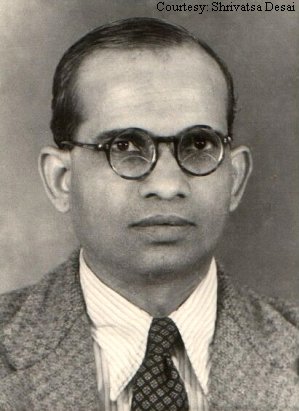Epigraphist P. B. Desai
by Jyotsna Kamat
First Online: December 06, 2004
Page Last Updated: December 07, 2024

Pandurangrao Bhimrao Desai (1910-1974)
The family name of 'Desai', indicates designation of high revenue officials. It is a common surname irrespective of caste and creed in Gujarat, Maharashtra, Karnataka and Goa states of India. Dr. Desai, well known epigraphist and historian was born to pious and devout Vaishnava (Madhva) Brahmin couple Bhimrao and Bhagirathibai in the village of Gurmitkal near Gulbarga on 24th of December in 1910. Bhimrao was a revenue official in Nizam's dominions to which Gulbarga district belonged earlier. Panduranga was the youngest among five sons. He was only six, when he lost his father, and it was left to the elder brothers to look after the family and educate younger brothers as was the practice.
Urdu was the state language then, and Marathi the medium of instruction through which the Kannada speaking youngsters had to study in Nizam's Hyderabad state. No doubt most of the students who were fortunate enough to get educated in that educationally backward region were good linguists, when they had to study through English medium in high school. Dr. Desai was such a polyglot. He took Sanskrit for his M.A degree. This background and his self-taught method in deciphering and reading inscriptions made him a full fledges scholar in epigraphy and ancient Indian Paleography. But all this, young Panduranga had to imbibe in a hard way.
He had to discontinue education even before graduation, due to serious illness and lack of resources. Later he started helping his elder brother Raghavendra Rao who had opened a national boarding school in Kuknur (in Raichur district), in running it and teaching. Both brothers were greatly influenced by Gandhiji's teachings and admitted students of all castes, which was unheard of, and a bold step in that area.
The small town of Kuknur was full of old temples worth lot of inscriptions. Out of sheer curiosity, Panduranga started to read and decipher the writing on stones. Kuknur was a great center of learning in medieval times. It had a ghatika (college of higher learning) as well. He bloomed as a self- taught epigraphist in five years, evolving his own method of deciphering alphabets which underwent change over centuries. He had collected two hundred pages of Kannada inscriptions in Kuknur and round about villages. His curiosity has now become a passion. Besides he undertook study of temple architecture, sculptures and memorial stones.
After a five year gap, he could complete B.A in 1935 from Karnatak college Dharwad and M.A from Bombay University. He earned distinction in Sanskrit.
He brought out a history of Vijayanagar empire on the occasion of its six-centenary in 1936. This work in Kannada established him as a historian at a very young age. His second book was in Marathi language on Maratha king Shivaji. He depicted Shivaji mainly from Kannada sources. Both books remained authoritative works for several years.
He joined the epigraphy branch of Department of Archeology, of Government of India in 1939. The salary was meager, but the subject was to his liking. He was in Ooty, where the office was shifted for seventeen years. The number of inscriptions he discovered, studied and recorded came to one thousand. He covered all the four districts of Mumbai-Karnataka and small native states, besides Tamil and Telugu inscriptions.
He was regular contributor to departmental journals and Epigraphia Indica - an international journal. His mastery in Sanskrit and other south Indian languages rendered unquestionable authenticity to interpretation or archaic writing on stones.
He accepted teaching assignment in 1957 at Karnatak University. Here he could get more time to edit volumes of inscriptions he collected earlier in personal capacity and write scholarly books. "A corpus of Kannada inscriptions from Hyderabad", "Jainism in South India and some Jaina Inscriptions" and "Basaveshvara and his times" are the masterly products of this period. As the Director of Kannada Research Institute, he brought out ten smaller publications like 'Shasanaparichaya' which have lasting value. As a professor, he introduced epigraphy as a subject at post-graduation level and was responsible to bring out a band of young epigraphists who later made a name in the field. He retired from active service, but kept on writing till his premature death in 1974.
He brought out a book of history of Ancient India in Kannada ably assisted by Dr. S.H. Ritti and late Dr. B.R. Gopal, both established historians and epigraphists. This book filled a big gap of an authoritative text over decades.
Dr. Desai's lasting contribution besides editing important inscriptions, is discovery of Buddhist centers in Karnataka, works on Shakti cult, Panduranga of Pandharpur and history of place names. He brought out glory of Karnataka beyond the region and the country and created awareness, through several literary works. He was a prolific writer in Kannada.
A felicitation volume of six hundred pages entitled Studies in Indian history and culture was presented on his 60th birthday. It is a rich tribute by his friends, students and scholars of repute to an extraordinary researcher and scholar of Karnataka.
Dr. Desai wrote thirty books in Kannada, ten in English and one in Marathi. In addition to a few children's stories, he also authored many historical novels in Kannada and his style was particularly well-suited to the genre. About four hundred and twenty articles in English and Kannada appeared besides. Considering the difficulties he faced to pursue his studies earlier, in addition to his frail health any state in India would have felt proud about his stupendous output. He was much more. A nationalist and patriot to the core, which traits outshine in his literary articles and books.
![]()
See Also:
- Indian Archaeology -- Topics on Archaeology of India; including guides to sculptures, memorials, and historical artifacts.
- History Potpourri -- Social and political history of India; includes history of freedom struggle, history of drinking, history of education, dynasties, and religious movements
- India's Historians

